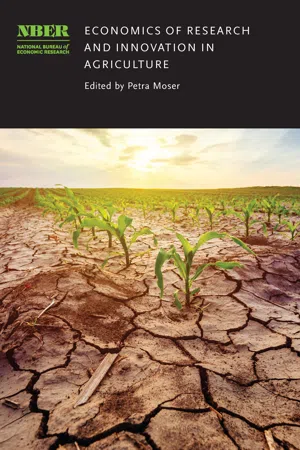![]()
1
The Roots of Agricultural Innovation
Patent Evidence of Knowledge Spillovers
Matthew Clancy, Paul Heisey, Yongjie Ji, and GianCarlo Moschini
1.1 Introduction
Changes in the technology of farming have profoundly affected US production agriculture over the past century (Gardner 2002). Myriad innovations adopted by farmers contributed to this transformation, including mechanization; vastly improved genetics for plants and animals; novel inputs such as fertilizers, pesticides, and antibiotics; and the reorganization of farming activities to exploit specialization and scale economies. The results are impressive: between 1950 and 2015, for example, the total factor productivity index for US agriculture increased by 167 percent compared to 97 percent for the US nonfarm private sector.1
Digging deeper into the causes of these waves of agricultural technical change uncovers the critical role played by past research and development (R&D) activities. Griliches’s (1957) pioneering work on the yield improvements due to hybrid maize found a large payoff to the cumulated past research investment in this technology: a benefit-cost ratio of 7, or an internal rate of return of about 40 percent. More broadly, for a set of studies published over the 1965–2005 period, the median estimate of the internal rate of return of agricultural R&D was 45 percent, or a benefit-cost ratio of about 10 (Fuglie and Heisey 2007).
R&D explicitly focused on agriculture, conducted by firms and public organizations, is obviously essential to agricultural innovation. Nonagricultural R&D, however, may also play a role via so-called knowledge spillovers. The most immediate output of R&D is new knowledge, but it has long been recognized that the R&D performed by one entity (e.g., a public lab, or a firm) in a given industry may have substantial productivity impacts outside this entity or industry (Griliches 1992). At a positive level, spillovers create serious challenges to the task of inferring, from data, what R&D effort had which effect on outcomes of interest.
In this chapter, we focus squarely on assessing the extent to which knowledge spillovers may impact agricultural innovation. With some caveats, discussed later, we find that our proxies for knowledge flows—citations to patents, citations to scientific papers, and novel text—suggest that more than 50 percent of knowledge spillovers originate in nonagricultural knowledge domains.
Knowledge spillovers have received limited attention in previous agricultural R&D studies. The typical econometric procedure has been to regress an estimate of agricultural productivity on relevant past R&D expenditures. To account for spillovers, some studies include broader measures of R&D expenditures. Attention has mostly concerned spillover between segments of agricultural R&D (Evenson 1989), or privileged spatial R&D spillovers—that is, across states or countries (Latimer and Paarlberg 1965; Khanna, Huffman, and Sandler 1994). Alston (2002) concludes that such spillovers are sizeable: interstate or international R&D spillovers may account for more than half of the measured agricultural productivity growth. Consideration of vertical spillover effects in agriculture is rare. One exception is Wang, Xia, and Buccola (2009), who relate public research in three life science fields (biology, agriculture, and medicine), and private research in two of these fields (agriculture and medicine), to research output (measured by patents) of private firms in agriculture and medicine.2
This chapter’s contribution is to provide new methods and data on the scope of knowledge spillovers in agriculture. In contrast to most studies in this area, we do not attempt to calculate the rate of return on R&D. Instead, we measure the extent of knowledge spillovers by directly observing proxies for knowledge flows and measuring the share of these that originate in nonagricultural knowledge domains. The goal is to provide new evidence on the extent to which agricultural technologies draw on knowledge originally developed outside of agriculture. We do so by developing various knowledge-flow proxies embedded in US agricultural patents granted over the 1976–2018 period.
Our initial step is to identify a set of relevant agricultural patents among the universe of US patents granted over this period. Note that while our analysis is restricted to US patents, these patents proxy global agricultural research. Depending on the subsector, we estimate that 14 percent to 49 percent of US agricultural patents are based on foreign research. We identify patents belonging to six distinct subsectors of agriculture: animal health, biocides, fertilizer, machinery, plants, and agricultural research tools (hereafter shortened to “research tools”). We chose these six subsectors because we can identify their patents with relative precision and because, while not exhaustive, they span the major biological, chemical, and mechanical technology fields that have contribu...
